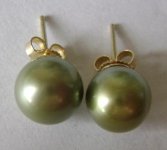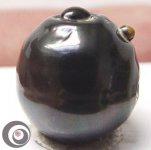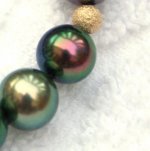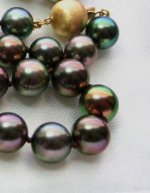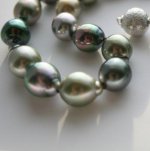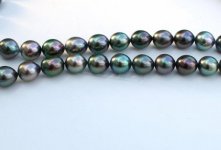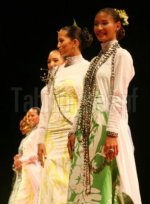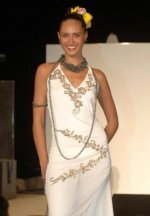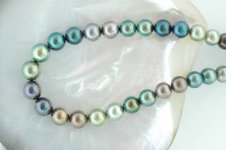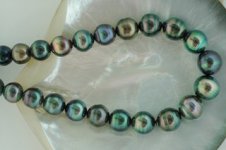Like you said, value is in the eyes of the beholder. My bracelet from TPM has two pistachio pearls and a chocolate pearl. One of the TPM pendant pearl I picked for my Mom also has a pistachio pearl. I don't see many of those two colors, based on my limited experience. I think the pistachio pearls are pretty, especially the ones with lots of gold in them. Not too thrill about chocolate though. Pistachio pearls are still considered a lighter color. However, the peacock and aubergine/eggplant exude a mysterious, exotic beauty and they glow on me better than pistachio. I notice that when setting pendant or strategically placing pistachio next to peacock and aubergine in a bracelet or necklace, that makes the piece really pop.
I just remembered that Jeanpn also said color does not factor into pricing in FP when she bought loose pearls. Price is based on luster, size, surface, etc.
Back in 1992, Robert Wan considered pistachio pearls as "rejects" until Glenda Queen and Pamela Butler started selling them, based on modernjeweler.com's article http://modernjeweler.com/web/online/Pearl-Gem-Profiles/Pistachio-Pearl/3$260. I am going to cut and paste in case they delete it in the future, since they stopped publishing recently.
Pistachio Pearl
Tone Poems
Posted: July 8th, 2008 05:26 PM EDT
By David Federman
Tahiti’s farmers have a kind of macho aesthetic for their pearls. Real pearls have robust colors and spit-shine luster. For years, as a result, pearls with lighter hues and softer glows were hidden away in junk drawers. Out of sight, out of mind, was the rule for undesirable pearls, especially when they had greenish-yellow body colors instead of the traditional gray or black. And it didn’t matter if these pearls had, as they often do, sweet overtones of rose or blue. The farmers could see only failure.
Today, when these pastel pearls have proved a smash hit with designers and jewelers all across America, they are praised only reluctantly by many of Tahiti's pearl growers. For them, real greens glow like Christmas ornaments and radium watch dials. That's why they often turn a deaf ear to customer requests for pale colors. "I have a standing order for light-toned yellowish-greens with a Tahitian pearl farmer who comes to see me regularly," says Glenda Queen of Union Street Goldsmiths in San Francisco. "Yet no matter how much or often I pester him for these goods, he never brings or sends me any."
That leaves Queen no choice but to call the queen of what are now called pistachio pearls, fellow San Franciscan and pearl dealer Pamela Butler of Ocean Gem Pearl Corp. The term pistachio pearl is a Butler coinage that dates from 1992, the year she visited Robert Wan, Tahiti's largest and most influential pearl grower, and just happened to catch sight of a bin brimming with these beauties whose colors suggested various mixtures of lemon and lime. "'What are these?' I asked him. 'Rejects,' he answered and explained, very apologetically, that they were five years worth of crop failures. 'I'll take them all,' I told him."
What did Butler see in that giant reject pile that Wan had missed? Quite simply, a golden opportunity to make a one-woman market in a whole new breed of pearl with subtle colors the likes of which no one had ever seen before. "The market for Tahitian pearls was still very small then and pretty much in the pocket of a couple of New York dealers who were very powerful and very clever," recalls Butler, who had been specializing in Polynesian pearls since 1987. "But I noticed that these market kingpins were focusing almost exclusively on classic Tahitian colors such as eggplant-purple and peacock-green. They, too, shared the farmers' contempt for pastel hues. I realized then and there that if I was going to build a successful business in black pearls, it would have to be with colors they had overlooked or ignored."
Butler couldn't have known it at the time, but her efforts on behalf of the soft-hued and light-toned pearls Wan considered rubbish would radically alter pearl aesthetics and pave the way for a revolution in taste.
MASCULINE/FEMININE
When Butler tapped the fashion world for the color-term pistachio to describe greenish-yellow Tahitian pearls, she was aware that she was taking what she calls a "feminine approach" to classifying pearls. "Categories like 'South Sea,' 'Akoya,' and 'freshwater' are very masculine and scientific," she says. "I wanted to use words that were more feminine and romantic to classify pastel pearls. After all, these are very cheery gems that give an emotional lift when a woman wears them. We need a language that conveys this sense of uplift."
Butler is on to something here. Pearls, which have for so long been considered a fashion gem, seem to lend themselves to description in evocative terms one is very used to seeing in highly sophisticated, ultra-poetic mail-order clothing catalogs from the likes of Coldwater Creek and The Territory Ahead. Copy writers for these catalogs rarely use abstract color names but, instead, prefer concrete ones. Thus purple becomes plum, olive becomes aloe, gold becomes thistle, and so on and so forth. "A whole generation of shoppers has learned to think of fabrics in terms of specific beverages, foods, plants, and the like," Butler continues. "This same naming technique has been harnessed to pearls with obvious success."
And how. After pistachio pearls caught on big as such with designers and jewelers, the market started to find catchy names for other pastel pearls. Light-toned coppery Tahitian pearls were dubbed bronze pearls. Those with crimson were christened cognac.
Now dealers and designers are thumbing through fashion catalogs and hue-name dictionaries in a hunt for spicy names that capture the spirit of other color-rich pearl varieties. Thus light-orange freshwater pearls from China are sold as apricot and its muted purples as lavender.
Meanwhile, color names adopted for Tahitian pearls have been elevated from descriptions to trade names. "It is amazing how these color names take on a life of their own," says John Bucher of Bucher Trading Co., New York. "People now talk about pistachio pearls as if they are a species in themselves."
From Butler's perspective, they are. And it is clearly one that other dealers share with her. In 1996, Golay Buchel New York launched a major market campaign for pistachio pearls, featuring a strand of them in an ad along with one white and one golden necklace. Coupling the pistachio strand with two others that possessed better-known colors helped the newer color find more immediate acceptance.
Two years later, says Fabrice Dessaint at the company's New York office, "Demand for pistachio pearls is running stronger than ever. I only wish supplies would keep up with it." So do jewelers.
Pistachio Tahitian cultured circle pearls courtesy of Elyria Pearls.
ModernJeweler
IMHO, it comes down to some marketing techniques by giving catchy names (for example cognac diamond sounds better than brown diamond). Catchy names sell better. Trendy people tend to buy chocolate pearls, for example. It is not even as popular as a few years ago. To each his own. I prefer the classic beauty of peacock & aubergine; and they remain timeless. But it doesn't mean I don't like pistachio pearls; just don't like them as much.

